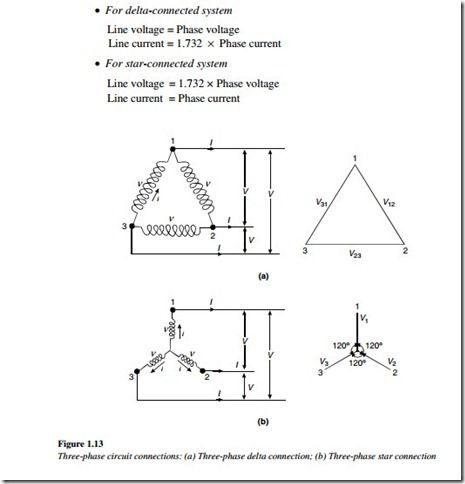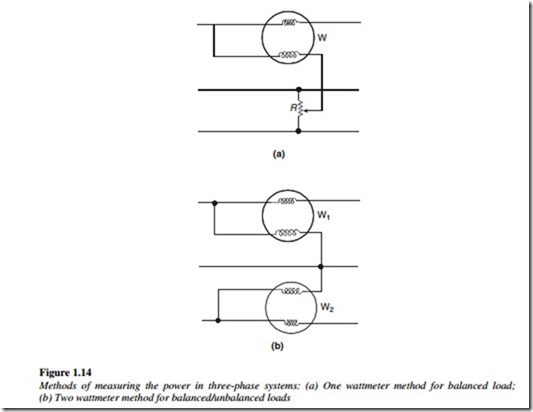AC power systems
Single-phase power system
The power in a single-phase system is shown in Figure 1.12. In the figure current (I ) lags voltage (V ) by an angle φ. The current has two components – the energy component and the watt less component. Only the energy component has a power value. Hence, the power in a single-phase circuit is given by the following equation:
Three-phase power systems
The three windings of a three-phase transformer or an alternator can be connected in either of two ways – delta or star as shown in the Figure 1.13. The relationship between the phase voltages and the currents, and the line voltages and the currents are as follows:
In a star connection, a neutral point is available. Generators are generally star-wound and the neutral point is used for earthing. Three-phase motors can be either delta- or star- connected. Usually, delta connections are used for low-voltage, small-size motors to reduce the size of the windings.
Three-phase currents are determined considering each phase separately and calculating the phase currents from the phase voltages and impedances. In practice, the calculations are simple and straightforward as three-phase systems are usually symmetrical, the loads being balanced. Most of the three-phase motors can be assumed as balanced loads. The calculations for currents, power, etc. can be done using the expression given below. However, for unsymmetrical or unbalanced systems, the calculations and expressions given below do not hold good, and complex calculations are required.
The power in a three-phase system is the sum of the power of the three phases. Let us consider a balanced delta- or star-connected system. The total power for the three-phase
system will be:
Power measurement in a three-phase system
Electrical power is measured with a wattmeter. A wattmeter consists of a current coil connected in series with load, while the other potential coil is connected parallel with load. Depending on the strength of each magnetic field movement, the pointer gets affected.
The true or real power is directly shown in a wattmeter. In three-phase systems, power can be measured using several methods. For temporary measurements, a single wattmeter
can be used. However, for permanent measurements, a three-phase wattmeter having two elements is used which indicates both balanced and unbalanced loads. For an unbalanced load, two wattmeters must be used as shown in the Figure 1.14. The total power is calculated by adding the measurement readings given by the two wattmeters. With this method, the power factor can also be obtained.
When using the two-wattmeter method, it is important to note that the reading of one wattmeter should be reversed if the power factor of the system is less than 0.5. In such a case, the leads of one wattmeter may have to be reversed in order to get a positivereading. In the case of a power factor less than 0.5, the readings must be subtracted instead of being added. The power factor of the three-phase system, using the two-
wattmeter method (W1 and W2) can be calculated as follows:
Since the sum and subtraction of readings are done to calculate total true power of a three-phase system, methods shown are not used practically in industry. Rather three- phase power analyzers are used which are more user-friendly.
Power factor meter
It is similar to a wattmeter in principle, only two armature coils are provided with mountings, on a single shaft. They are 90° apart from each other. Both armature coils rotate as per their magnetic strengths. One coil moves proportional to the restive component of the power, while the other coil moves proportional to the inductive component of the power.
(b) Two wattmeter method for balanced/unbalanced loads
Energy meter
This shows the amount of power (electric energy) used over a certain period. In a watt- hour meter, there are two sets of windings. One is the voltage winding while the other is the current winding. The field developed in the voltage windings causes current to be induced in an aluminum disk. The torque produced is proportional to the voltage and current in the system. The disk in turn is connected to numeric registers that show electric energy used in terms of kilowatt-hours.





